Blog
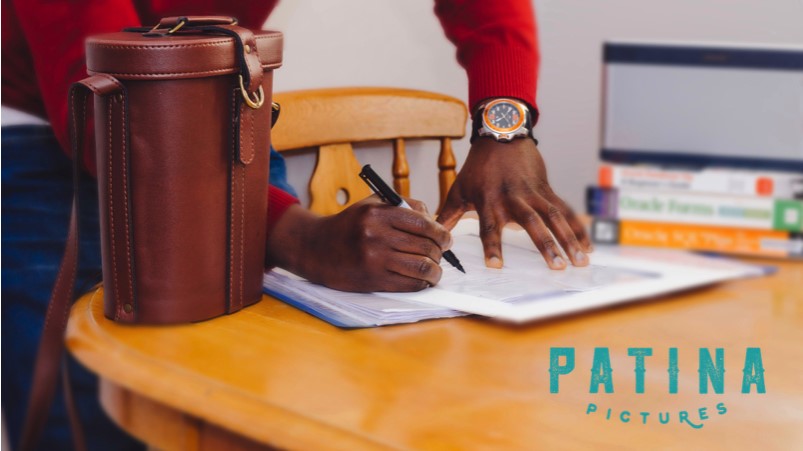
May '20 | 5 Tips to Improve Your Home Office Video Backdrop
Over these last few months we’ve been honored to virtually step into our clients’ living room, garage, closet-turned-home-office, to help make home offices more production for self-tapes and remote capture of video. No one minded the optics– health, safety, and finding a space that afforded two hours of quiet became the priority.
But now that it’s apparent our work from home mandate is going to last longer than anticipated, perhaps it’s time to make our home office more inviting and send an impression that says:
We’ve Got This!
(Even if on the inside we’re still saying, Oh Hell No!)
Because, as one of our amazing video clients Carol Isozaki, shares with us:
Calling All Leaders: Watch this amazing 90 second reminder about first impressions
and check out @Carol_Isozaki or StrategicBrandIntelligence.com.
So with that in mind, here are 5 useful video tips to improve your home office video backdrop.
1. Setting the Frame SETTING THE FRAME
Check H2 CHECK H2
Check H3 CHECK H3
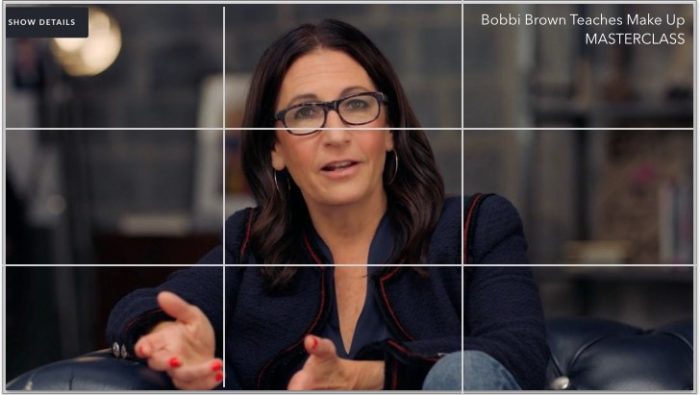
As a general rule of thumb, eyes should be positioned in the top third of frame and the body should take up the middle third of frame.
This allows you to be the main focus, not your background. It also allows the camera to capture body language.
To attain this frame we suggest you’re an arms-length distance away from the computer’s camera and that you invest in a simple computer stand (or a stack of books) so that the camera is eye level.
Ladies – if the camera is lower than eye level, the chin and neck tend to get a lot of screen time.
Men – if the camera is higher than eye level, the top of the head becomes a main focus.
2. Lighting
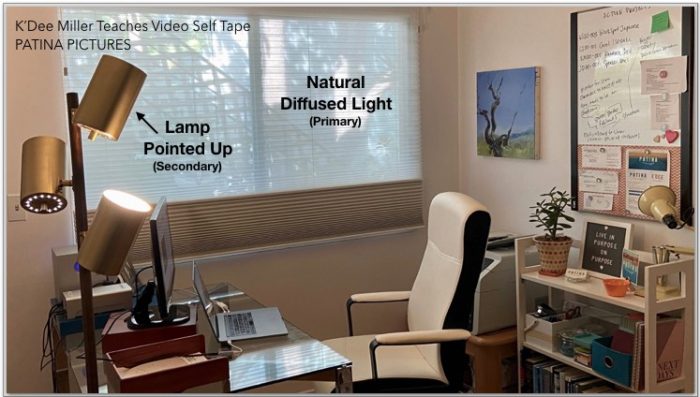
When trying to get the best lighting for a Zoom video, or similar, choose a room with soft natural light and use the window as your primary lighting source. If you get direct sun through the window, we suggest angling the blinds or diffusing the light with a gauzy, white material, sheet, or by installing a top-down-bottom-up curtain such as the one pictured above.
Angle your computer or recording device close enough to the window so that the light falls naturally across your face. We do not suggest that the window become part of your video set. Windows, even when diffused, often blow out on low-sensor cameras creating unnecessary contrast in your video.
If you don’t have a room with natural light invest in a floor lamp, such as the above, and point the light source toward the ceiling or wall so that it bounces softly across the face. Do not angle the light directly at your face, it’ll create an unnatural (and often unflattering) spotlight.
We suggest turning off all overhead lighting, as those often cast odd and unflattering shadows.
3. Art Direction
Psychologist and writer Thomas Moore believed that an individual’s living space was a direct representation of their soul. Now, whether you subscribe to that or not, your background is stating something about you!
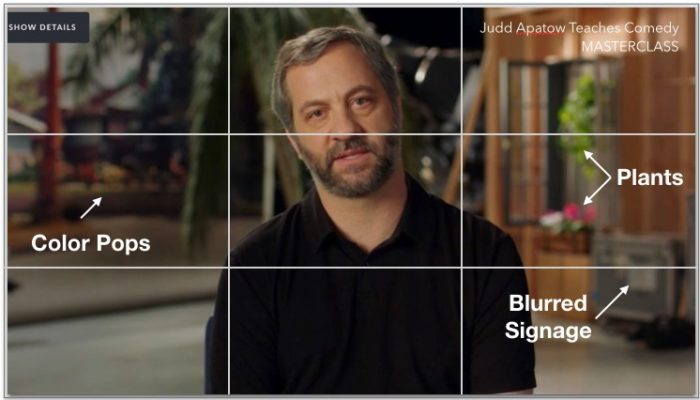
Over the past few months, we’ve seen a lot of home office video calls shot against bookshelves. Books can be colorful backgrounds as long as we can’t make out their titles. If we can, well, books say a lot about their owner. So make sure your titles are sending the right message.
The same goes with artwork. If you have a big piece of art it can provide a lively background. But we suggest angling the camera so that only a section of the painting can be seen, otherwise your audience may drift away from your message and toward critiquing your artwork.
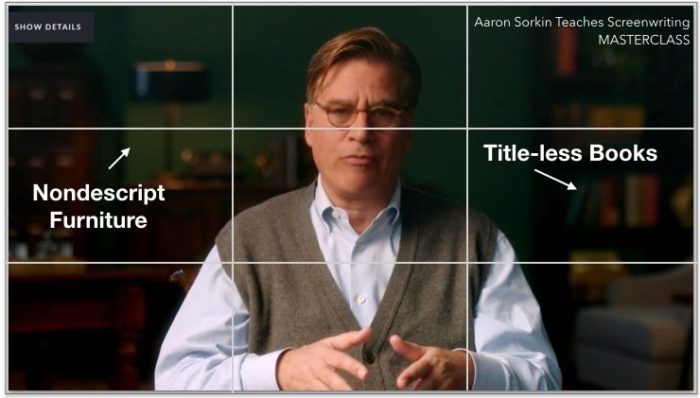
Furniture can also send a message. So many news commentators are now broadcasting from their living room. This is fine but make sure it is YOU we’re focused on, not the fact that your living room was lifted from the latest Ikea catalogue.
A few other things to stay away from:
- Shooting against a blank white wall;
- Shooting against a bright solid color like red, blue, green;
- Shooting against a reflective surface like a window, or a piece of furniture that has glass doors, or a framed piece of artwork. You don’t want your “behind the scenes” reflected on your set.
A few best practices when it comes to setting:
- If you want to shoot against a wall, lighter, softer tones often look more flattering on camera.
- Small, nondescript items of color can be placed in the background, or on the shelves, to break up too much white space.
- Plants can be used in corners, or on shelves, to provide a bit of life.
- If you’ve got white boards or cork boards behind you, tack up a few colored note cards to break up the color scheme. (It also makes it look like you’ve been very busy in quarantine!) And make sure the camera is far enough away so that you’re not advertising the content of your white board notes.
We suggest using Google Hangout or Zoom when no one is present and testing out your background before going live. You may need to move things around and do some good ol’ fashion staging.
4. Audio
Ideally you can find a quiet place away from kids, neighbors, or street noise. But if you can’t, use headphones. Even a set of generic headphones will cut out a lot of background noise. Plus if you’re in an empty space, headphones will cut out echos.
But make sure your headphones aren’t rubbing up against fabric, or jewelry, as that can cause a distracting rustle or clank. If you use a lot of hand gestures, you’ll also want to be aware of that mic so you don’t accidentally bump it.
5. Wardrobe & Make Up
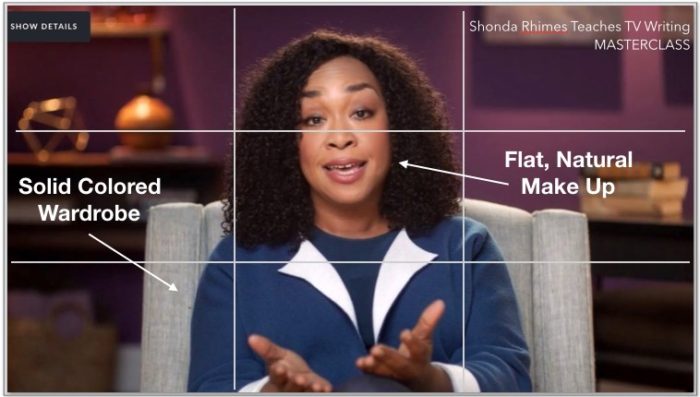
When it comes to wardrobe for producing your home office video we suggest wearing what you typically wear to work– (sorry folks, pajamas are no longer accepted)– and focus on solid, bright colors that bring out your natural skin tones.
We suggest staying away from the following:
- Dressing in solid whites or blacks as they tend to create unnecessary contrast;
- Shirts with small patterns or stripes can often cause moire on camera;
- Colors that are the same as your background may not provide enough definition;
- Distracting logos, (and logos in general) can often become a trademark issue.
When applying your own makeup stick with flat foundations, powders and blushes. Stay away from anything that provides a shimmer, or bronzer, as that sparkle can often become intensified on camera.
If you don’t typically wear makeup but want something that helps with shine we suggest ordering a transparent powder such as MAC’s Prep + Prime Transparent Finishing Prime.
If you or your company needs help with video self-tapes or the remote capture of video, we’re here– in our own version of home office– ready to assist.
Until then, we’ll be learning from the master’s on MASTERCLASS. What are you learning while in Quarantine?
Categorized under: Video Production Tips & Tricks
